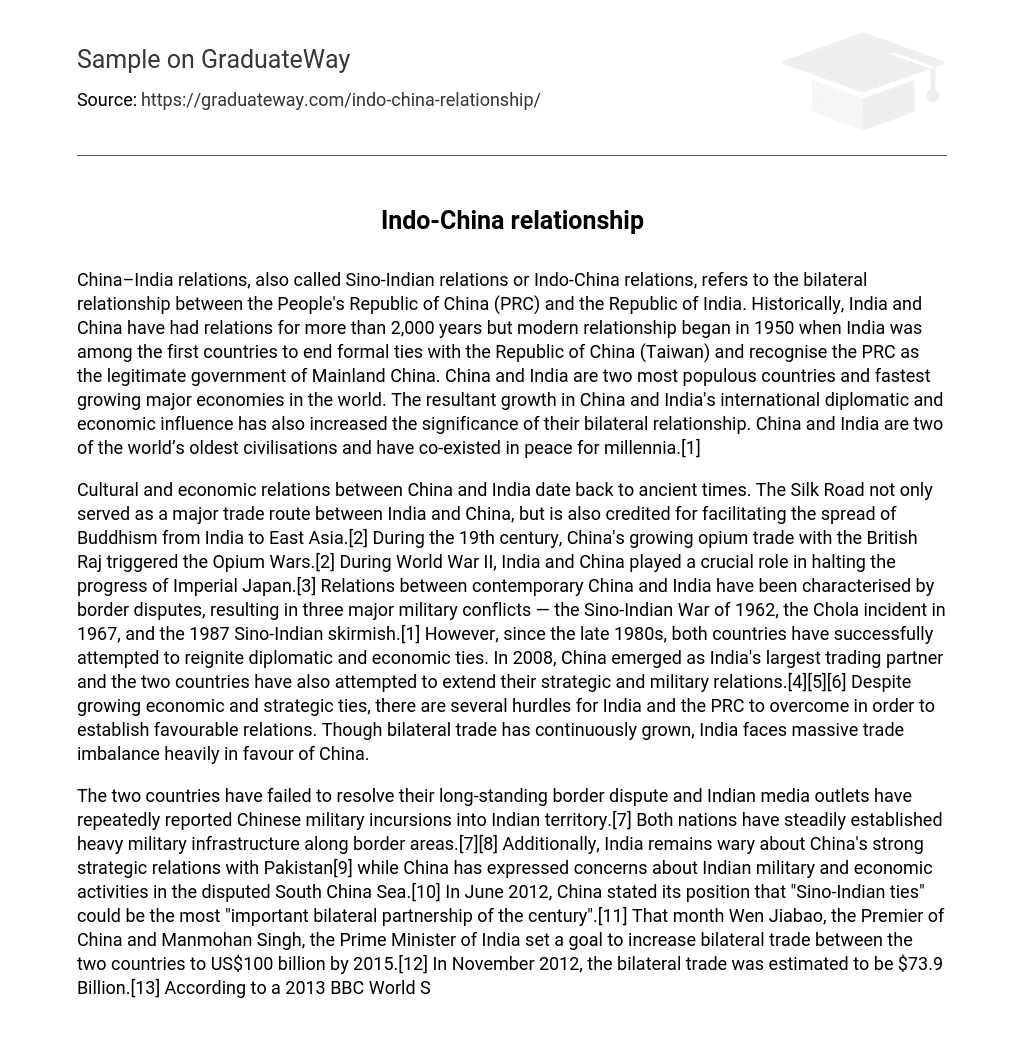China–India relations, also called Sino-Indian relations or Indo-China relations, refers to the bilateral relationship between the People’s Republic of China (PRC) and the Republic of India. Historically, India and China have had relations for more than 2,000 years but modern relationship began in 1950 when India was among the first countries to end formal ties with the Republic of China (Taiwan) and recognise the PRC as the legitimate government of Mainland China. China and India are two most populous countries and fastest growing major economies in the world. The resultant growth in China and India’s international diplomatic and economic influence has also increased the significance of their bilateral relationship. China and India are two of the world’s oldest civilisations and have co-existed in peace for millennia.[1]
Cultural and economic relations between China and India date back to ancient times. The Silk Road not only served as a major trade route between India and China, but is also credited for facilitating the spread of Buddhism from India to East Asia.[2] During the 19th century, China’s growing opium trade with the British Raj triggered the Opium Wars.[2] During World War II, India and China played a crucial role in halting the progress of Imperial Japan.[3] Relations between contemporary China and India have been characterised by border disputes, resulting in three major military conflicts — the Sino-Indian War of 1962, the Chola incident in 1967, and the 1987 Sino-Indian skirmish.[1] However, since the late 1980s, both countries have successfully attempted to reignite diplomatic and economic ties. In 2008, China emerged as India’s largest trading partner and the two countries have also attempted to extend their strategic and military relations.[4][5][6] Despite growing economic and strategic ties, there are several hurdles for India and the PRC to overcome in order to establish favourable relations. Though bilateral trade has continuously grown, India faces massive trade imbalance heavily in favour of China.
The two countries have failed to resolve their long-standing border dispute and Indian media outlets have repeatedly reported Chinese military incursions into Indian territory.[7] Both nations have steadily established heavy military infrastructure along border areas.[7][8] Additionally, India remains wary about China’s strong strategic relations with Pakistan[9] while China has expressed concerns about Indian military and economic activities in the disputed South China Sea.[10] In June 2012, China stated its position that “Sino-Indian ties” could be the most “important bilateral partnership of the century”.[11] That month Wen Jiabao, the Premier of China and Manmohan Singh, the Prime Minister of India set a goal to increase bilateral trade between the two countries to US$100 billion by 2015.[12] In November 2012, the bilateral trade was estimated to be $73.9 Billion.[13] According to a 2013 BBC World Service Poll, 36% of Indians view China positively, with 27% expressing a negative view, whereas 23% of Chinese people view India positively, with 45% expressing a negative view.[14] Geographical overview
(The border between the People’s Republic of China and the Republic of India over Arunachal Pradesh/South Tibet reflects actual control, without dotted line showing claims.) China and India are separated by the formidable geographical obstacles of the Himalayas. China and India today share a border along the Himalayas with Nepal and Bhutan acting as buffer states. Parts of the disputed Kashmir region claimed by India are claimed and administered by either Pakistan (Azad Kashmir and Gilgit and Baltistan) or by the PRC (Aksai Chin). The Government of Pakistan on its maps shows the Aksai Chin area as mostly within China and labels the boundary “Frontier Undefined” while India holds that Aksai Chin is illegally occupied by the PRC. China and India also dispute most of Arunachal Pradesh at the far eastern end of the Himalayas. However, both countries have agreed to respect the Line of Actual Control here; the area just north of Tawang is seen as a potential flashpoint.[citation needed] Country comparison
Republic of India
People’s Republic of China
Population
1,210,193,422[15]
1,339,724,852 (2010 Census)
Area
3,287,240 km² (1,269,210 sq mi)
9,640,821 km² (3,704,427 sq mi)
Population density
382/km² (922/sq mi)
139.6/km² (363.3/sq mi)
Capital
New Delhi
Beijing
Largest city
Mumbai
Shanghai
Government
Federal republic, Parliamentary
Democracy
Socialist, Single-party state
First Leader
Jawaharlal Nehru
Mao Zedong
Current Leader
Manmohan Singh
Xi Jinping
Official languages
Hindi, English, Assamese, Bengali, Gujarati, Kannada, Kashmiri, Konkani, Malayalam, Marathi, Manipuri, Nepali, Oriya, Punjabi, Sanskrit, Tamil, Telugu and Urdu (See Languages with official status in India) Standard Chinese (Mandarin), Mongolian, Tibetan, Uyghur, Zhuang (See Languages of China) Main religions
Hindu (80.5%), Muslim (13.4%), Christian (2.3%), Sikh (1.9%) Buddhist (0.8%), Jain (0.4%) other religions (0.6%)[16] see also Religion in India >10% each: non-religious, folk religions and Taoism, Budhism.





